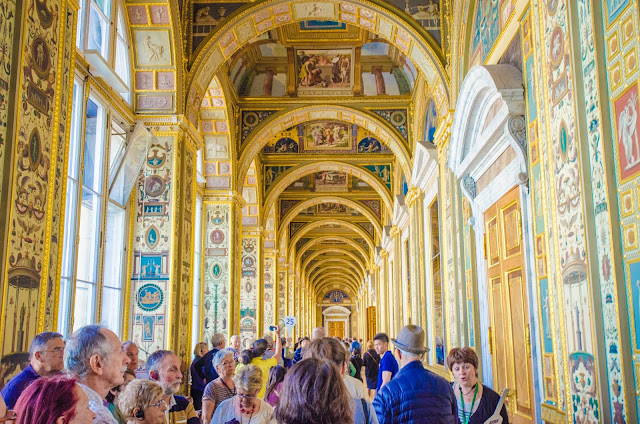There are a few places left at the very top of our "to see" list, and St. Petersburg is one of those. It was a real treat for us to be able to explore this beautiful old city. We had arranged for a car and guide, a great decision as it turned out. Our guide, a recent college graduate in architecture, was extremely knowledgeable. She not only gave us the history, but also some insights into life here today. As you might expect, while this city is very different we found that we also have much in common. We noted that the small local shops we visited all offered free coffee or vodka, your choice. Now THAT is hospitality!
St. Petersburg (Санкт-Петербург) was founded by Peter the Great in 1703. The name of the city was changed from St. Petersburg to Petrograd, then Leningrad, and then back to St. Petersburg in 1991. The city served as the capital of Russia until 1918 when the government was moved to Moscow. St. Petersburg remains the cultural capital of Russia.
 |
The Church of the Savior on Spilled Blood
(Церковь Спаса на Крови, Tserkovʹ Spasa na Krovi)
The Church of the Savior on Spilled Blood (Церковь Спаса на Крови, Tserkovʹ Spasa na Krovi) was built on the site where Emperor Alexander II was wounded and died in March 1881 from a grenade thrown by an anarchist conspirator. Construction of the church, on the Griboedov Canal, began in1883 and was completed in1907. The architecture of the church stands out as it is Medieval Russian of a style referred to as romantic nationalism. This is a sight that we will not forget.
|










 |
| the Griboyedov Canal |
 |
Old Saint Petersburg Stock Exchange
and Rostral Columns |
 |
| Yes, that is definitely an advert for Coca Cola. We also passed a Subway shop and one of the pizza chain restaurants. Scott also noted loads of Fords on the streets of St. Petersburg. |
 |
| Kazan Cathedral or Kazanskiy Kafedralniy Sobor (Каза́нский кафедра́льный собо́р) |
 |
| Mariinsky Palace, also known as Marie Palace (Мариинcкий дворец) |
 |
| Saint Isaac's Cathedral or Isaakievskiy Sobor (Исаа́киевский Собо́р) |
 |
| The Winter Palace is home to the Hermitage Museum facing Palace Square and the Alexander Column |
The Alexander Column (Aleksandrovskaia Kolonna) stands in front of the Winter palace in the Palace Square in the center of St Petersburg. It was built between 1830 and 1834. The monument was erected after the Russian Victory over Napoleon. The column is named for Emperor Alexander I who reigned over Russia from 1801 to 1825.
 |
| The State Hermitage (Госуда́рственный Эрмита́ж) |
The Hermitage is an absolutely huge museum housed in a complex that seems to go on forever. It was founded in 1764 by Catherine the Great. The Hermitage collection includes over three million items. We didn't have time to see them all but what we saw was nothing short of fantastic! The museum property includes the Winter Palace once the home of Russian emperors.
 |
| The State Hermitage (Госуда́рственный Эрмита́ж) |

 |
Death of Adonis, Giuseppe Mazzuola
(1641-1725) |

 |
| Zeus |
 |
The Crouching Boy
Michelangelo (1530-1534) |
 |
| St. Nicholas' Cathedral (known locally as the Sailors' Cathedral) |
 |
The Peter and Paul Cathedral in Peterhof (Собор Святых Петра и Павла)
this is a great example of Russian Revival architecture |
 |
| Summer Gardens at the Peterhof |
 |
| Grand Peterhof Palace and the Grand Cascade |
About an hours drive out of the city is the summer palace and gardens of Peter the Great. The Peterhof Palace (
Петерго́ф) was the vision and creation of Peter. The complex, built along the seacoast, includes a number of dramatic palaces, beautiful gardens and fountains. Plans for the Palace and grounds have been traced back to Peter's writings in 1705 with construction beginning in 1714. The central royal chateau is built on an elevated bluff and is modeled after Versailles.
Just below the Grand Palace is the Grand Cascade (Bolshoi Kaskad). At the base of the cascade is a Sea Channel (Morskoi Kanal) connecting the palace to the sea.
There is some very clever engineering at work here as there are no pumps to power all of the fountains at the Peterhof. All of the fountains are supplied from natural springs feeding reservoirs in the Upper Gardens. Gravity and the elevation difference between the upper and lower gardens is then used to power the water show, and what a grand show it is! We could have spent days walking around these gardens, unfortunately we had only a single day to take it all in.
 |
| one side ofthe Grand Cascade |
 |
| the channel connecting the palace to the sea |
 |
| Church Wing of Grand Peterhof Palace (Церковный корпус Большого Петергофского дворца) |
 |
| Peterhof Palace ( Петерго́ф) |
 |
The Dragon and Chessboard Hill Cascade
These guys were created by sculptor Conrad Ossner and placed here in 1739. |
This cascading fountain looked contemporary to us and seemed to be a modern addition. Not so! We were surprised to learn that the Dragon and the Chessboard Hill Cascade was actually started under the direction of Peter the Great and that these brightly colored dragons have been here since 1739. How about that.
We had a fantastic time exploring St. Petersburg and, if the opportunity ever presented itself again, would jump at the chance to go back. There is so much to see and do here: far more than could ever be done in a day. Of course, having seen St. Petersburg, now we are hoping for a chance to visit Moscow. Maybe, someday….
















































No comments:
Post a Comment